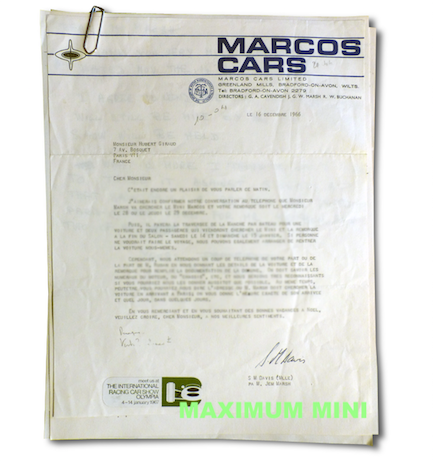It is with great regret that I heard of the passing of Hubert Giraud on July 19 after being contacted by his son Alexandre yesterday.
Giraud was the last of the original team members who raced the Mini Marcos car at Le Mans in 1966. The two original drivers (Jean-Louis Marnat & Claude Ballot-Lena) both passed away many years ago, while the man who’d originally built the car, Jean-Claude Hrubon, had sadly died just days before me securing the deal on the car. His first mechanic, Claude Plisson, had also followed after I had just tracked him down...
That made Giraud the last man to find, and again it took time, but fortunately I did visit him and his wife Christine in their beautiful house on the outskirts of Paris a few years ago. Giraud had not only been the team's boss, he was also the man who'd sacrificed his Morris Cooper ‘S’ to have the Marcos built and the man who paid for all the expenses!
He was 81 when we met in December 2018 and his memories about the events were crystal clear. He'd also kept records in little notebooks writing out all his expenses for every year. We found both the Cooper 'S' base vehicle as the Mini Marcos shell back in them easily enough. Giraud even had the original Marcos brochure with prices scribbled in French francs on it. Next came out a map with documentation, pictures and letters. Some of these were from Marcos boss Jem Marsh, who wanted to have the car on display at the 1967 Racing car Show. With Giraud speaking hardly any English and Marsh hardly speaking any French, communication between the two men proved a challenge, but it worked out well thanks to Marsh' secretary - Miss SM Davis - who spoke French. She wrote these letters with Marsh simply signing them off and the car made it to the show (I'm still looking for more photographs). Monsieur Giraud allowed me to copy all of the correspondence, including a hand written list of all the other people involved at the Le Mans project. His brother was one of the ‘chronos’ and they had some people standing along several corners of the track to keep on eye on the little car.
Last but not least he told me they had overalls made with Mini Marcos patches sewed on them. I’d seen these on a few historical photographs and had thought of remaking these also, but now he showed me two of the original spare patches, one that was handed over to me. It was a truly wonderful meeting.
With Hubert Giraud's death a chapter in the Mini Marcos' rich racing history has ended. I wish his wife and children all the best. Repose en paix a un grand monsieur.
Giraud with a model of the 1966 Le Mans Mini Marcos. He was the team boss and backer
Picture Jeroen Booij
Giraud in 1967 with his brother Bernard and the two Le Mans cars built by Hrubon: the 1966 Mini Marcos and the 1967 Hrubon Thélème on the right. The Marcos was repainted at this stage to match the Hrubon
Picture Jeroen Booij archive
A letter from Marcos Cars to confirm the Marcos' appearance at the '67 Racing Car Show
Picture Jeroen Booij archive
Hubert Giraud (right) with his wife Christine and myself just outside Paris in December 2018
Picture Jeroen Booij archive


































